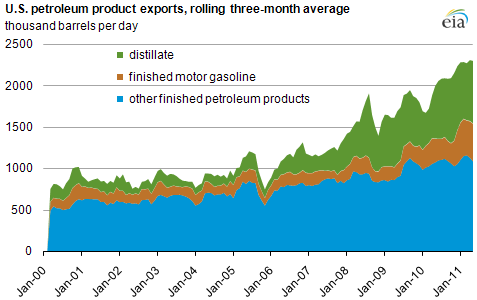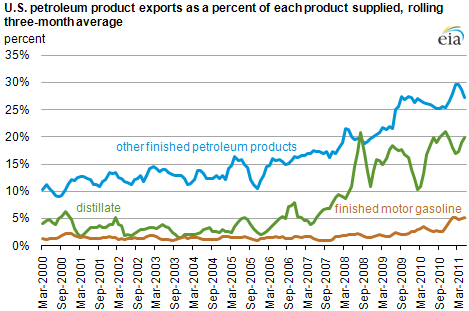
U.S. exports of petroleum products increase as markets become more globally integrated

Note: Other finished petroleum products include residual fuel, kerosene-type jet fuel, napthas, asphalt, petroleum coke and other oils.
Download CSV Data
Total U.S. exports of finished petroleum products have increased more than 60% since 2007 as markets have become more globally integrated. This trend is driven primarily by finished motor gasoline and distillate fuel oil which are increasingly exported to Latin America. Annual U.S. exports of gasoline and distillate increased by 133% and 144%, respectively, from 2007 to 2010.
Both exports and imports are a normal part of global trade, but the volume of petroleum products exported from the United States is a small portion of U.S. consumption of those products. From 2000 through 2009, motor gasoline exports were generally 1% - 2% of motor gasoline product supplied (a proxy for demand). From 2010 to mid-2011, they have averaged close to 4%, reaching a high in December 2010 of 5.8%. Distillate exports, which include diesel fuels and fuel oils, represent a more significant share of total available product. From 2000 to 2008, distillate exports were less than 10% of distillate product supplied in all but two months. From the beginning of 2009 to mid-2011, distillate exports were more than 10% of distillate product supplied.

Note: Other finished petroleum products include residual fuel, kerosene-type jet fuel, napthas, asphalt, petroleum coke and other oils.
Download CSV Data
In petroleum product markets, Europe and Canada have been the traditional trading partners of the United States, with the volume of products shipped across the Atlantic tied in large part to the current price differences for delivery to the New York Harbor compared to Rotterdam, Amsterdam.
Over the last several years, other regions have become increasingly involved in the trade of petroleum products. Rising demand and tight supply in Latin America, together with a decline or leveling off of U.S. product demand, have have led to the growth in U.S. exports to that region.